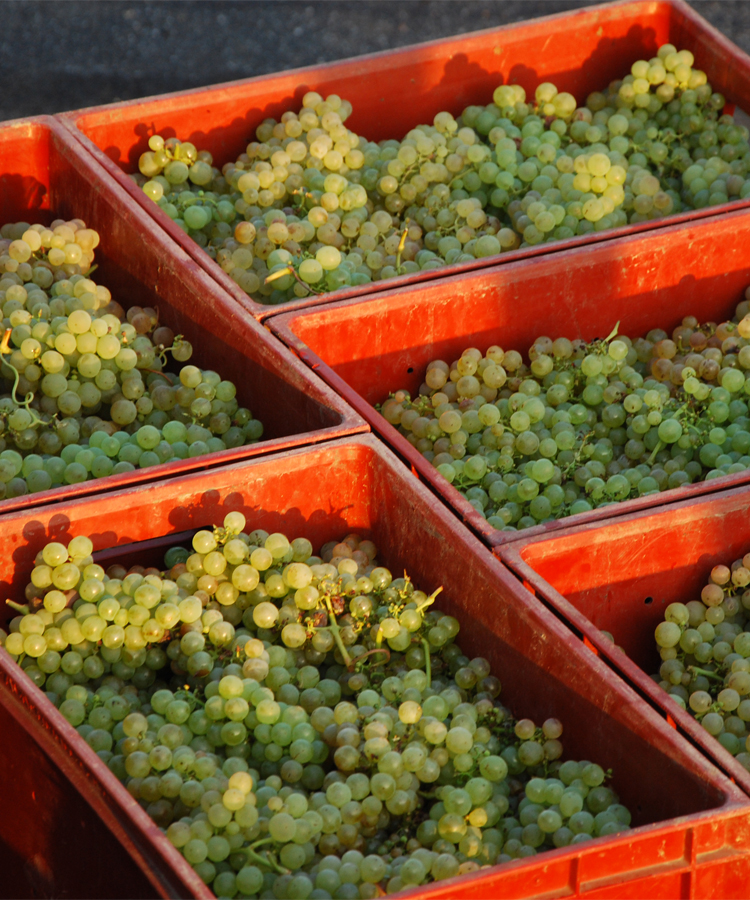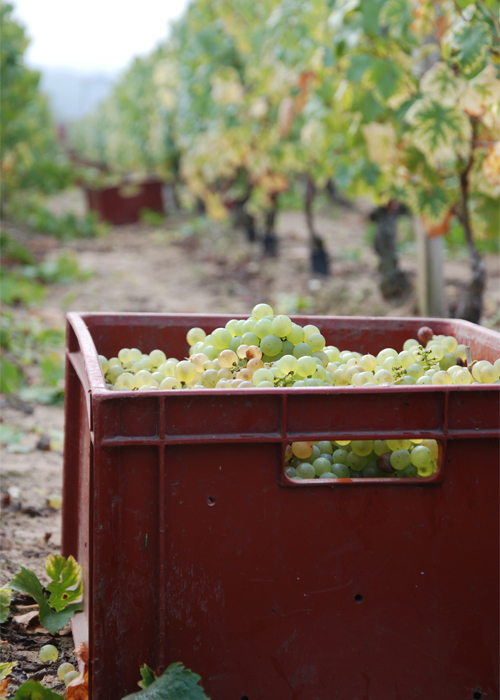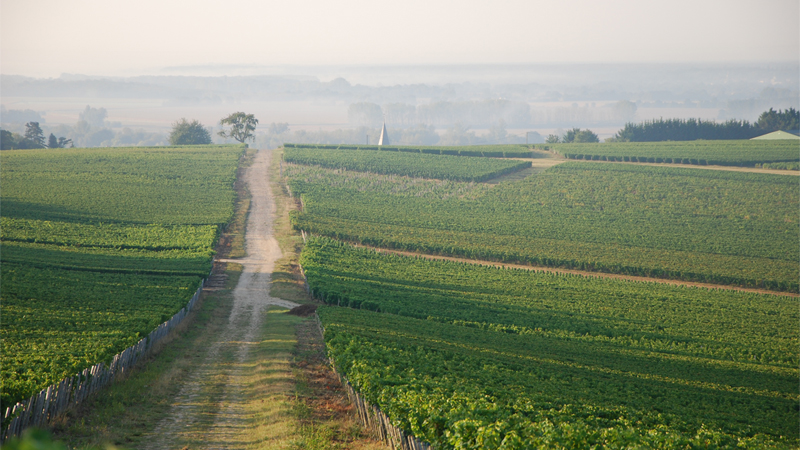
France’s Loire Valley is home to one of the most diverse, robust, and exciting wine-producing scenes on the planet. Home to 61 appellations, four major regions, and 70,000-plus hectares of rolling vineyards as far as the eye can see, it goes without saying that the region holds something for every palate — though knowing the region’s grapes is key to understanding what’s behind a label.
We’re breaking down everything you need to know about the Loire Valley’s most important grape varieties, brought to you by Saget La Perrière. Grab your glasses and get ready for a tasty adventure ahead!
White Grapes
Chenin Blanc
Love flavor-packed whites marked by fruit-driven flavors and heaps of natural acidity? Then Chenin Blanc needs to be on your radar. This versatile variety is the backbone to countless bottles of Loire Valley whites, as its vinification potential knows no limits. Chenin Blanc produces wines all over the flavor spectrum, ranging from bone dry to sticky sweet (late-harvest and dessert-style wines) in both still and sparkling formats. Chenin Blanc is regarded as a relatively neutral canvas in the world of vinification, meaning it has the ability to greatly reflect the terroir, vintage and estate from which it comes.
Chenin Blanc is cultivated across numerous appellations in the Loire Valley, though its greatest “claim-to-fame” regions include Anjou, Saumur, Vouvray, Savennières, and Coteaux du Layon. Well-crafted Chenin Blanc is generally medium- to full-bodied, structured, and high in acidity, the latter two of which ensure that these wines can withstand the test of time in the cellar.
For a “haute-couture” approach to Chenin Blanc, check out the wines of Château de la Mulonnière, located in the heart of Beaulieu-sur-Layon. Known for its sustainably farmed vineyards and schist-dominant soils, these estate-produced wines promise to satisfy a variety of palates, from wine drinkers looking for bone-dry expressions to those seeking something a bit sweet (for the latter, dive into the domaine’s cuvées from Coteaux du Layon and Quarts de Chaume).
Tasting Notes for Dry Wines: Green apple, honey, quince, white flowers, crushed rocks
French-Inspired Food Pairing: Pungent cheeses (think triple-cream Brie or Gruyère), savory gratins, or sweet tart tatins (an epic dessert wine pairing!)
Sauvignon Blanc
Crisp, zesty, and undeniably refreshing — it’s no surprise that Sauvignon Blanc is beloved by wine drinkers worldwide. This high-acid white variety is known for producing some of the most refreshing white wines on the market, though expressions from the Loire Valley are extra special.
While New World Sauvignon Blancs tend to err on the grassy, tropical-fruit-driven side of things, Sauvignon Blanc from the Loire Valley is known for its citrus-forward and minerally flavors. The most popular expressions of Loire Valley Sauvignon Blanc are crafted in the appellations of Sancerre and Pouilly-Fumé, though the grape is grown all across the region (Reuilly, Quincy, Touraine, and beyond).
Saget La Perrière is no stranger to growing Loire Valley Sauvignon Blanc. The family has been cultivating this high-acid variety for nine generations in Pouilly-sur-Loire, and today, has expanded its lineup to include single-vineyard bottlings that illustrate the unique typicity of fruit grown in the region’s signature Kimmeridgian clay-limestone soils. Elegant, airy, and light on their feet, these impeccably balanced bottles are perfect go-tos for hosting French-inspired apéros at home.
Tasting Notes: Lemon, lime, citrus rind, flint, wet stones, chalk
French-Inspired Food Pairing: Warm goat cheese (chèvre) salad or fresh-shucked oysters
Chasselas
Although less popular than Chenin and Sauvignon Blanc, Chasselas plays a major role in the Loire Valley’s Pouilly-sur-Loire appellation. Originally from western Switzerland, this zippy variety is known for producing lively, light- to medium-bodied wines that are as refreshing as they are tasty.
Contrary to other appellations in the Loire, Chasselas is the star of the show In Pouilly-sur-Loire, with Sauvignon Blanc playing the supporting role (smaller percentages are permitted in final blends). This small yet fierce appellation covers just 60 hectares and is located on the Right Bank of the Loire, just opposite the region’s famous Sancerre appellation. Although most of the appellation’s wineries have ripped out their Chasselas in favor of more “fashionable” Sauvignon Blanc, Saget La Perrière has maintained a handful of their unique plots for the sake of preserving regional tradition – sipping its “Les Sablons” is basically like drinking history.
Tasting Notes: Stone fruit, wet stones, honeysuckle, almond skin, grilled nuts
French-Inspired Food Pairing: Vegetable-laden omelettes, leeks with vinaigrette, or buttery brioches
Other Notable Loire Valley White Grapes to Discover: Melon de Bourgogne, Romorantin, Folle Blanche, Pinot Gris
Red Grapes
Cabernet Franc
In the realm of Loire Valley reds, Cabernet Franc reigns supreme. This peppery, earth-driven variety produces medium-bodied wines that are perfect for serving with a variety of foods and sipping chilled year-round. Originally from Bordeaux, this black-skinned grape variety made its way up north and has since established itself as the red grape of the Loire Valley.
Cabernet Franc is grown all over the Loire Valley, though its main homes are found in the appellations and sub-appellations of Anjou-Saumur and Touraine. The grape is known for its medium acid and medium to high levels of tannins. In addition to producing world-class, monovarietal reds, Cabernet Franc is also commonly blended with Grolleau, Pinot Noir, and other Loire Valley varieties. (Insider note: Cabernet Franc is also a parent variety to a handful of popular grapes, including Merlot, Carménère, and Cabernet Sauvignon.)
Tasting Notes: Strawberry, raspberry, red currant, bell pepper, fresh cut herbs, gravel
French-Inspired Food Pairing: Steak frites, sautéed mushrooms, cassoulet, duck confit — you really can’t go wrong with a good Loire Valley Cab Franc.
Pinot Noir
Pinot Noir is one of the most widely planted red grape varieties across the globe, though Loire Valley expressions are unique in their own right. Loire Valley Pinots tend to be lean, high-acid, and marked by stonier and more earth-driven flavors than their New World counterparts.
Although cultivated across the region, Pinot Noir in the Loire Valley mostly finds its home in Sancerre, Menetou-Salon, and other Middle Loire sub-appellations. While the grape is most commonly vinified as a still red, some producers choose to use the variety in their sparkling wine production (as done in Champagne), as the grape’s high acidity and solid structure make it the perfect candidate for bubbly vinification.
Tasting Notes: Wild berries, strawberries, citrus rind, potting soil, gravel
French-Inspired Food Pairing: Hearty coq au vin or duck a l’orange
Gamay
If you love wines from Beaujolais, then giving Loire Valley Gamay a go is definitely a great idea. These zesty, fruit-driven expressions of the grape are often a bit leaner than their Bojo-based mates, as the Loire Valley’s cool climate keeps acid high and ripeness levels relatively low.
Loire Valley Gamay is vinified both on its own and in blends (generally with Pinot Noir, Grolleau, and/or Cabernet Franc). For a delicious and thirst-quenching chillable red, Loire Valley Gamay is just the ticket.
For a survey of Loire Valley reds, check out the lineup of wines produced at Domaine des Grandes Espérances, situated in the heart of Touraine. These juicy red wines are produced from Cabernet Franc, Gamay, Pinot Noir, and Cot (Malbec), grown in a mosaic of soil types dominated by sand and gravel. Accessible, fun, and super easy to drink, these wines offer something for every palate preference — and best of all, fruit for each of these wines is farmed sustainably, making them solid, environmentally friendly go-tos.
Tasting Notes: Cherry, raspberry, red currant, rose petals, white pepper
French-Inspired Food Pairing: Baked ratatouille or simple cheese/charcuterie boards
Cot (Malbec)
Although more frequently associated with Argentina nowadays, Malbec actually finds its roots in France. The grape originated in Bordeaux, though like Cabernet Franc, Malbec made its way north and established a home in the Loire, where it regionally goes by the name “Cot.”
Cot-based wines from the Loire Valley tend to be leaner, lighter-bodied and higher in acid than their South American and Bordeaux-based counterparts, though moderate levels of soft tannins are still present. These food-friendly bottles are fruit-driven, bold, and provide a thought-provoking alternative to varietal expressions produced elsewhere.
Tasting Notes: Juicy red fruits, red flower petals, violets, sweet spice
French-Inspired Food Pairing: Savory crepes or gooey croque monsieur sandwiches
Other Notable Loire Valley Red Grapes to Discover: Grolleau, Pineau d’Aunis, Cabernet Sauvignon, Pinot Meunier
This article is sponsored by Saget La Perrière


